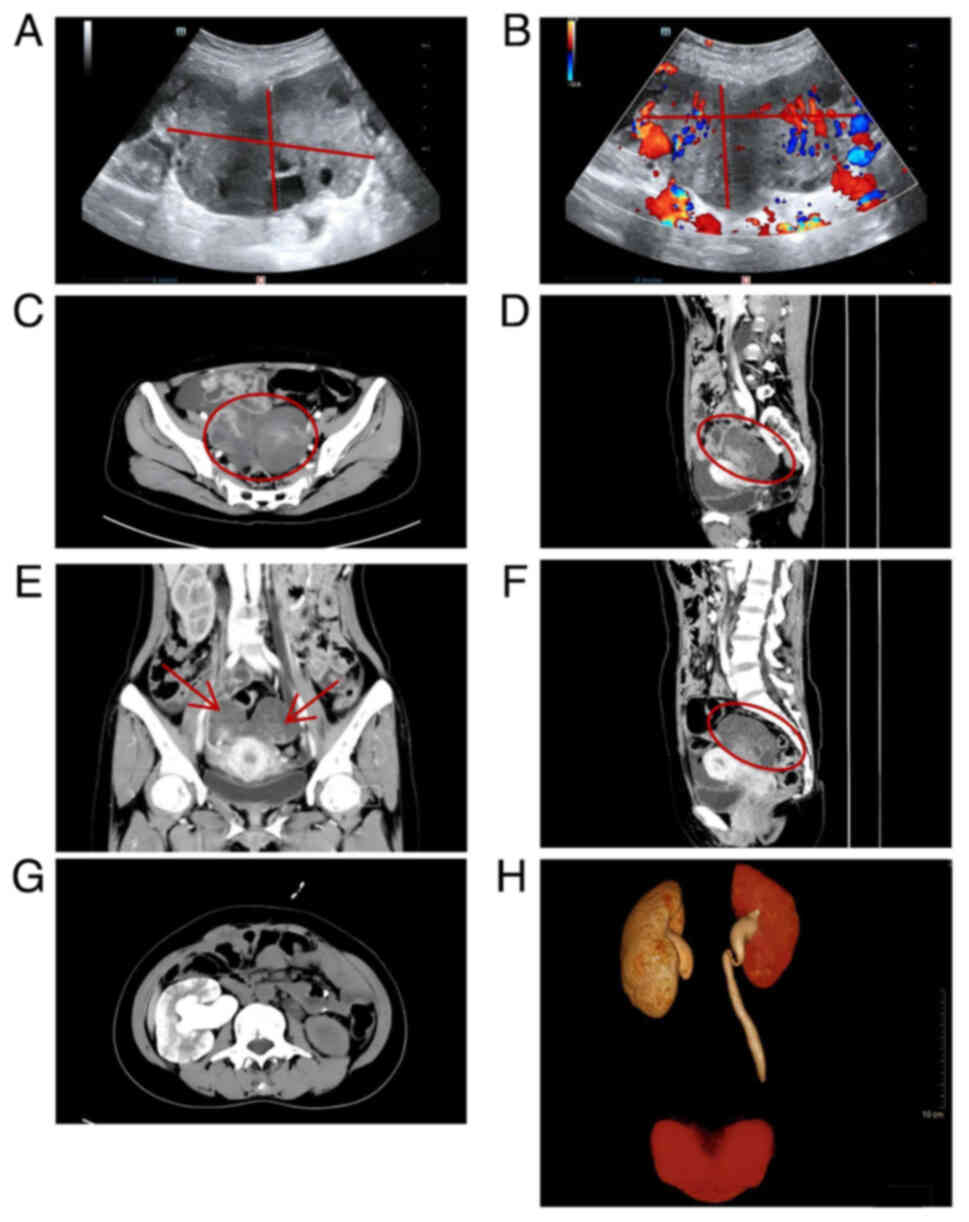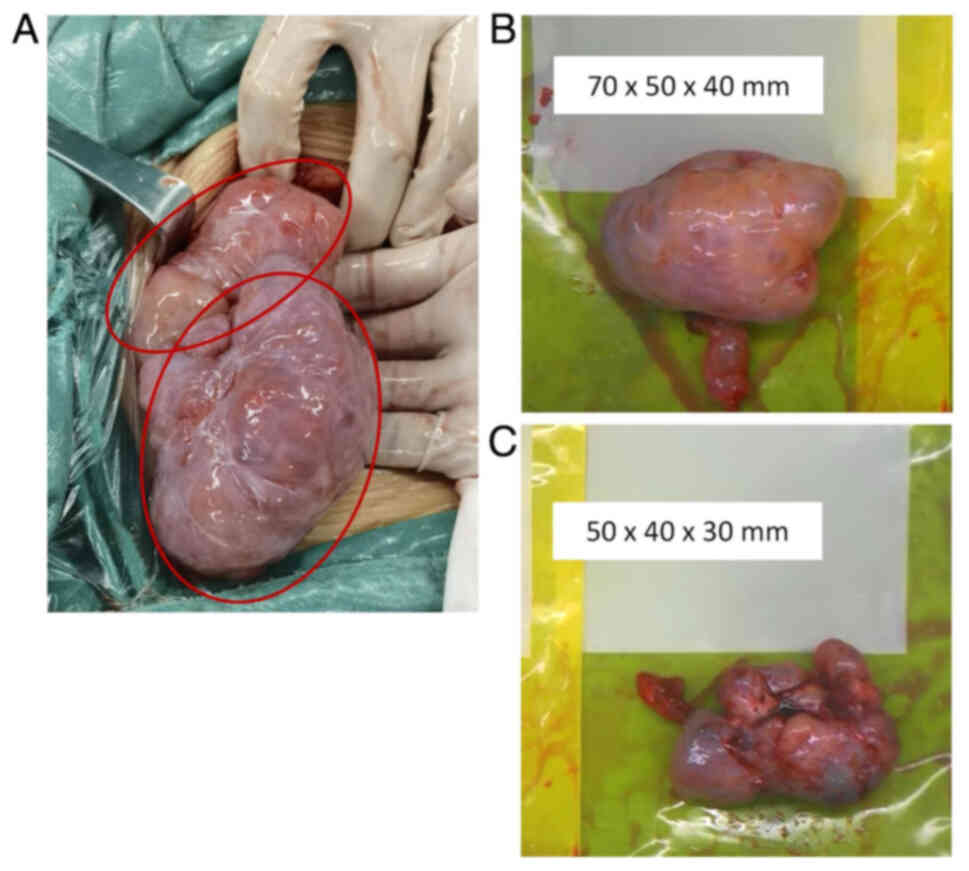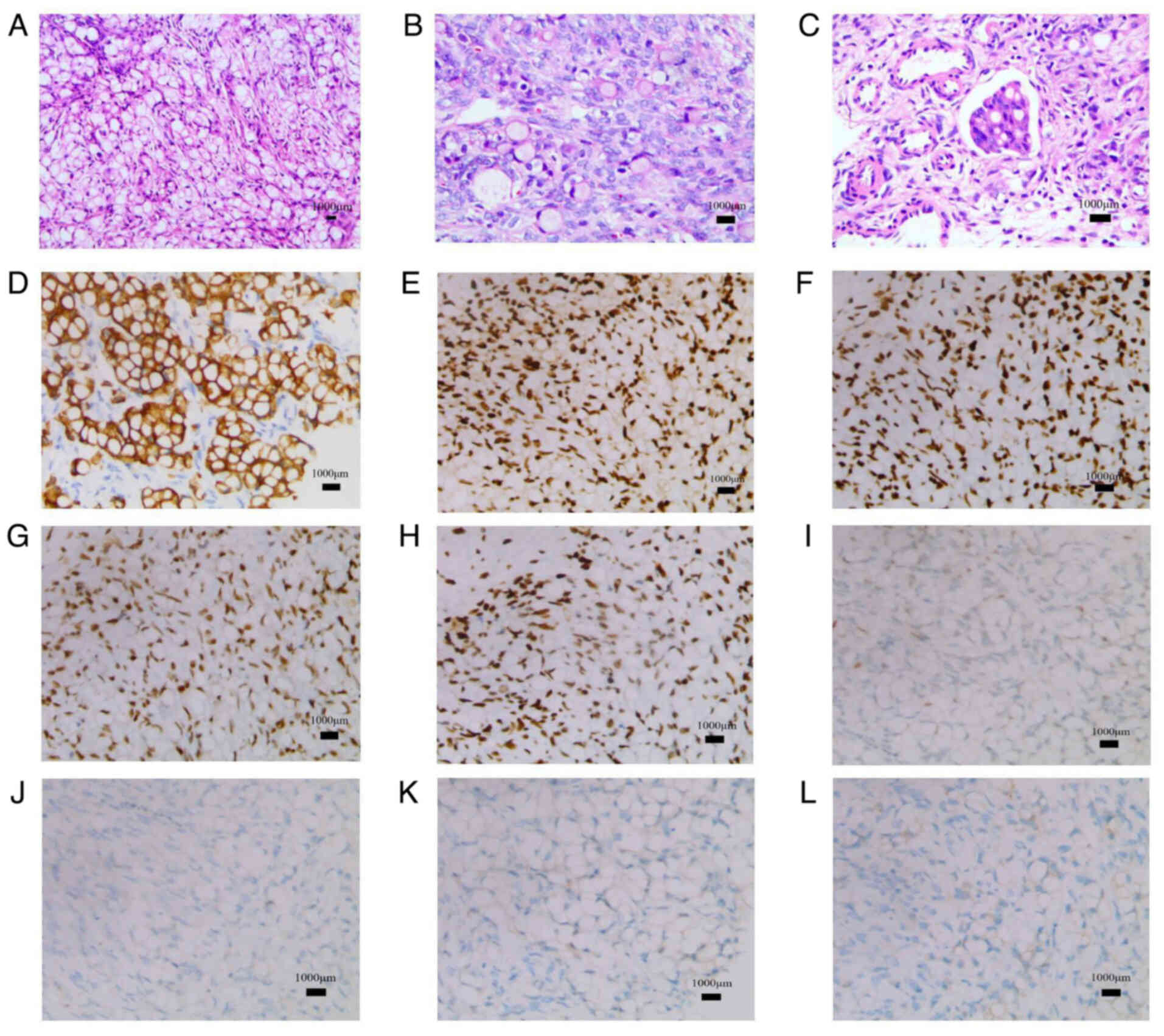|
1
|
Kossai M, Leary A, Scoazec JY and Genestie
C: Ovarian cancer: A heterogeneous disease. Pathobiology. 85:41–49.
2018. View Article : Google Scholar : PubMed/NCBI
|
|
2
|
Al-Agha OM and Nicastri AD: An in-depth
look at Krukenberg tumor an overview. Arch Pathol Lab Med.
130:1725–1730. 2006. View Article : Google Scholar : PubMed/NCBI
|
|
3
|
Kiyokawa T, Young RH and Scully RE:
Krukenberg tumors of the ovary a clinicopathologic analysis of 120
cases with emphasis on their variable pathologic manifestations. Am
J Surg Pathol. 30:277–299. 2006. View Article : Google Scholar : PubMed/NCBI
|
|
4
|
Yada-Hashimoto N, Yamamoto T, Kamiura S,
Seino H, Ohira H, Sawai K, Kimura T and Saji F: Metastatic ovarian
tumors: A review of 64 cases. Gynecol Oncol. 89:314–317. 2003.
View Article : Google Scholar : PubMed/NCBI
|
|
5
|
Kodama M, Moeini A, Machida H, Blake EA,
Grubbs BH and Matsuo K: Feto-maternal outcomes of pregnancy
complicated by Krukenberg tumor: A systematic review of literature.
Arch Gynecol Obstet. 294:589–598. 2016. View Article : Google Scholar : PubMed/NCBI
|
|
6
|
Wang B, Tang Q, Xu L, Teng X, Ding W, Ren
G and Wang X: A comparative study of RTK gene status between
primary tumors, lymph-node metastases, and Krukenberg tumors. Mod
Pathol. 34:42–50. 2021. View Article : Google Scholar : PubMed/NCBI
|
|
7
|
Timar J and Kashofer K: Molecular
epidemiology and diagnostics of KRAS mutations in human cancer.
Cancer Metastasis Rev. 39:1029–1038. 2020. View Article : Google Scholar : PubMed/NCBI
|
|
8
|
Prior IA, Hood FE and Hartley JL: The
frequency of ras mutations in cancer. Cancer Res. 80:2969–2974.
2020. View Article : Google Scholar : PubMed/NCBI
|
|
9
|
Cook JH, Melloni GEM, Gulhan DC, Park PJ
and Haigis KM: The origins and genetic interactions of KRAS
mutations are allele- and tissue-specific. Nat Commun. 12:18082021.
View Article : Google Scholar : PubMed/NCBI
|
|
10
|
Cox AD, Fesik SW, Kimmelman AC, Luo J and
Der CJ: Drugging the undruggable RAS: Mission possible? Nat Rev
Drug Discov. 13:828–851. 2014. View
Article : Google Scholar : PubMed/NCBI
|
|
11
|
Downward J: Targeting RAS signalling
pathways in cancer therapy. Nat Rev Cancer. 3:11–22. 2003.
View Article : Google Scholar : PubMed/NCBI
|
|
12
|
Hsu WH, LaBella KA, Lin Y, Xu P, Lee R,
Hsieh CE, Yang L, Zhou A, Blecher JM, Wu CJ, et al: Oncogenic KRAS
drives lipofibrogenesis to promote angiogenesis and colon cancer
progression. Cancer Discov. 13:2652–2673. 2023. View Article : Google Scholar : PubMed/NCBI
|
|
13
|
Lee D, Jang MK, Seo JH, Ryu SH, Kim JA and
Chung YH: ARD1/NAA10 in hepatocellular carcinoma: Pathways and
clinical implications. Exp Mol Med. 50:1–12. 2018. View Article : Google Scholar : PubMed/NCBI
|
|
14
|
Vokshi BH and Toska E: Mutant ARID1A:
Igniting cancer immunotherapy. Trends Immunol. 45:565–567. 2024.
View Article : Google Scholar : PubMed/NCBI
|
|
15
|
Mullen J, Kato S, Sicklick JK and Kurzrock
R: Targeting ARID1A mutations in cancer. Cancer Treat Rev.
100:1022872021. View Article : Google Scholar : PubMed/NCBI
|
|
16
|
Takeda T, Banno K, Okawa R, Yanokura M,
Iijima M, Irie-Kunitomi H, Nakamura K, Iida M, Adachi M, Umene K,
et al: ARID1A gene mutation in ovarian and endometrial cancers
(Review). Oncol Rep. 35:607–613. 2016. View Article : Google Scholar : PubMed/NCBI
|
|
17
|
Fontana B, Gallerani G, Salamon I, Pace I,
Roncarati R and Ferracin M: ARID1A in cancer: Friend or foe? Front
Oncol. 13:11362482023. View Article : Google Scholar : PubMed/NCBI
|
|
18
|
Lim JH, Park JW and Chun YS: Human arrest
defective 1 acetylates and activates beta-catenin, promoting lung
cancer cell proliferation. Cancer Res. 66:10677–10682. 2006.
View Article : Google Scholar : PubMed/NCBI
|
|
19
|
Maxwell MB, Hom-Tedla MS, Yi J, Li S,
Rivera SA, Yu J, Burns MJ, McRae HM, Stevenson BT, Coakley KE, et
al: ARID1A suppresses R-loop-mediated STING-type I interferon
pathway activation of anti-tumor immunity. Cell.
187:3390–3408.e3319. 2024. View Article : Google Scholar : PubMed/NCBI
|
|
20
|
Goswami S and Sharma P: Loss of ARID1A
‘loops’ in STING. Trends Immunol. 45:568–570. 2024. View Article : Google Scholar : PubMed/NCBI
|
|
21
|
Berek JS, Renz M, Kehoe S, Kumar L and
Friedlander M: Cancer of the ovary, fallopian tube, and peritoneum:
2021 update. Int J Gynaecol Obstet. 155 (Suppl 1):S61–S85. 2021.
View Article : Google Scholar
|
|
22
|
Classic pages in obstetrics and
gynecology, . Friedrich Ernst Krukenberg: Fibrosarcoma ovarii
mucocellulare (carcinomatodes). Archiv für Gynäkologie, vol 50, pp.
287–321, 1896. Am J Obstet Gynecol. 117:5751973.PubMed/NCBI
|
|
23
|
Kubeček O, Laco J, Špaček J, Petera J,
Kopecký J, Kubečková A and Filip S: The pathogenesis, diagnosis,
and management of metastatic tumors to the ovary: A comprehensive
review. Clin Exp Metastasis. 34:295–307. 2017. View Article : Google Scholar : PubMed/NCBI
|
|
24
|
Zhou Z, Li C, Wang Z, Haybaeck J and Zhang
C: Cd44v6 acts as a directional responding factor in the process of
transcoelomic metastasis from gastric carcinoma to Krukenberg
tumor. Expert Rev Mol Diagn. 23:583–588. 2023. View Article : Google Scholar : PubMed/NCBI
|
|
25
|
Thakur P, Sharma M, Chauhan A, Pal KM,
Thakur S, Gupta M and Kaushal S: Colorectal origin: A marker of
favorable outcome in Krukenberg Tumor? Results from Clinical and
Prognostic Analysis. South Asian J Cancer. 13:99–105. 2024.
View Article : Google Scholar : PubMed/NCBI
|
|
26
|
Wu F and Zhao X, Mi B, Feng LU, Yuan NA,
Lei F, Li M and Zhao X: Clinical characteristics and prognostic
analysis of Krukenberg tumor. Mol Clin Oncol. 3:1323–1328. 2015.
View Article : Google Scholar : PubMed/NCBI
|
|
27
|
Scully RE and Sobin LH: Histologic typing
of ovarian tumors. Arch Pathol Lab Med. 111:794–795.
1987.PubMed/NCBI
|
|
28
|
Karaosmanoglu AD, Onur MR, Salman MC,
Usubutun A, Karcaaltincaba M, Ozmen MN and Akata D: Imaging in
secondary tumors of the ovary. Abdom Radiol (NY). 44:1493–1505.
2019. View Article : Google Scholar : PubMed/NCBI
|
|
29
|
Zhang M, Shi M, Yu Y, Sang J, Wang H, Shi
J, Duan P and Ge R: The immune subtypes and landscape of
advanced-stage ovarian cancer. Vaccines (Basel). 10:14512022.
View Article : Google Scholar : PubMed/NCBI
|
|
30
|
Guo J, Yu J, Song X and Mi H: Serum CA125,
CA199 and CEA combined detection for epithelial ovarian cancer
diagnosis: A meta-analysis. Open Med (Wars). 12:131–137. 2017.
View Article : Google Scholar : PubMed/NCBI
|
|
31
|
Wang Y, Liu L and Yu Y: Mucins and
mucinous ovarian carcinoma: Development, differential diagnosis,
and treatment. Heliyon. 9:e192212023. View Article : Google Scholar : PubMed/NCBI
|
|
32
|
Matsas A, Stefanoudakis D, Troupis T,
Kontzoglou K, Eleftheriades M, Christopoulos P, Panoskaltsis T,
Stamoula E and Iliopoulos DC: Tumor markers and their diagnostic
significance in ovarian cancer. Life (Basel).
13:16892023.PubMed/NCBI
|
|
33
|
Hu J, Khalifa RD, Roma AA and Fadare O:
The pathologic distinction of primary and metastatic mucinous
tumors involving the ovary: A re-evaluation of algorithms based on
gross features. Ann Diagn Pathol. 37:1–6. 2018. View Article : Google Scholar : PubMed/NCBI
|
|
34
|
Hall C, Clarke L, Pal A, Buchwald P,
Eglinton T, Wakeman C and Frizelle F: A review of the role of
carcinoembryonic antigen in clinical practice. Ann Coloproctol.
35:294–305. 2019. View Article : Google Scholar : PubMed/NCBI
|
|
35
|
Locker GY, Hamilton S, Harris J, Jessup
JM, Kemeny N, Macdonald JS, Somerfield MR, Hayes DF and Bast RC Jr;
ASCO, : ASCO 2006 update of recommendations for the use of tumor
markers in gastrointestinal cancer. J Clin Oncol. 24:5313–5327.
2006. View Article : Google Scholar : PubMed/NCBI
|
|
36
|
Sturgeon CM, Duffy MJ, Stenman UH, Lilja
H, Brünner N, Chan DW, Babaian R, Bast RC Jr, Dowell B, Esteva FJ,
et al: National Academy of clinical biochemistry laboratory
medicine practice guidelines for use of tumor markers in
testicular, prostate, colorectal, breast, and ovarian cancers. Clin
Chem. 54:e11–e79. 2008. View Article : Google Scholar : PubMed/NCBI
|
|
37
|
Ozcan A, Shen SS, Hamilton C, Anjana K,
Coffey D, Krishnan B and Truong LD: PAX 8 expression in
non-neoplastic tissues, primary tumors, and metastatic tumors: A
comprehensive immunohistochemical study. Mod Pathol. 24:751–764.
2011. View Article : Google Scholar : PubMed/NCBI
|
|
38
|
Berg KB and Schaeffer DF: SATB2 as an
immunohistochemical marker for colorectal adenocarcinoma: A concise
review of benefits and pitfalls. Arch Pathol Lab Med.
141:1428–1433. 2017. View Article : Google Scholar : PubMed/NCBI
|
|
39
|
Kuroki L and Guntupalli SR: Treatment of
epithelial ovarian cancer. BMJ. 371:m37732020. View Article : Google Scholar : PubMed/NCBI
|
|
40
|
Kuhns KJ, Zhang G, Wang Z and Liu W:
ARD1/NAA10 acetylation in prostate cancer. Exp Mol Med. 50:1–8.
2018. View Article : Google Scholar : PubMed/NCBI
|
|
41
|
Wu RC, Wang TL and Shih IM: The emerging
roles of ARID1A in tumor suppression. Cancer Biol Ther. 15:655–664.
2014. View Article : Google Scholar : PubMed/NCBI
|
|
42
|
Chia NY and Tan P: Molecular
classification of gastric cancer. Ann Oncol. 27:763–769. 2016.
View Article : Google Scholar : PubMed/NCBI
|
|
43
|
Zang ZJ, Cutcutache I, Poon SL, Zhang SL,
McPherson JR, Tao J, Rajasegaran V, Heng HL, Deng N, Gan A, et al:
Exome sequencing of gastric adenocarcinoma identifies recurrent
somatic mutations in cell adhesion and chromatin remodeling genes.
Nat Genet. 44:570–574. 2012. View Article : Google Scholar : PubMed/NCBI
|
|
44
|
Wang K, Kan J, Yuen ST, Shi ST, Chu KM,
Law S, Chan TL, Kan Z, Chan AS, Tsui WY, et al: Exome sequencing
identifies frequent mutation of ARID1A in molecular subtypes of
gastric cancer. Nat Genet. 43:1219–1223. 2011. View Article : Google Scholar : PubMed/NCBI
|
|
45
|
Halazonetis TD, Gorgoulis VG and Bartek J:
An oncogene-induced DNA damage model for cancer development.
Science. 319:1352–1355. 2008. View Article : Google Scholar : PubMed/NCBI
|
|
46
|
Vogelstein B and Kinzler KW: Cancer genes
and the pathways they control. Nat Med. 10:789–799. 2004.
View Article : Google Scholar : PubMed/NCBI
|
|
47
|
Xue W, Zender L, Miething C, Dickins RA,
Hernando E, Krizhanovsky V, Cordon-Cardo C and Lowe SW: Senescence
and tumour clearance is triggered by p53 restoration in murine
liver carcinomas. Nature. 445:656–660. 2007. View Article : Google Scholar : PubMed/NCBI
|
|
48
|
Fang X, Lee YH, Jang JH, Kim SJ, Kim SH,
Kim DH, Na HK, Kim KO, Baek JH and Surh YJ: ARD1 stabilizes NRF2
through direct interaction and promotes colon cancer progression.
Life Sci. 313:1212172023. View Article : Google Scholar : PubMed/NCBI
|
|
49
|
Wu CH, Tseng CH, Huang KH, Fang WL, Chen
MH, Li AFY and Wu CW: The clinical signiicance of ARID1A mutations
in gastric cancer patients. Formosan J Surg. 53:93–100. 2020.
View Article : Google Scholar
|
|
50
|
Okamura R, Kato S, Lee S, Jimenez RE,
Sicklick JK and Kurzrock R: ARID1A alterations function as a
biomarker for longer progression-free survival after
anti-PD-1/PD-L1 immunotherapy. J Immunother Cancer. 8:e0004382020.
View Article : Google Scholar : PubMed/NCBI
|
|
51
|
Botta GP, Kato S, Patel H, Fanta P, Lee S,
Okamura R and Kurzrock R: SWI/SNF complex alterations as a
biomarker of immunotherapy efficacy in pancreatic cancer. JCI
Insight. 6:e1504532021. View Article : Google Scholar : PubMed/NCBI
|
|
52
|
Goswami S, Chen Y, Anandhan S, Szabo PM,
Basu S, Blando JM, Liu W, Zhang J, Natarajan SM, Xiong L, et al:
ARID1A mutation plus CXCL13 expression act as combinatorial
biomarkers to predict responses to immune checkpoint therapy in
mUCC. Sci Transl Med. 12:eabc42202020. View Article : Google Scholar : PubMed/NCBI
|
|
53
|
Li L, Li M, Jiang Z and Wang X: ARID1A
mutations are associated with increased immune activity in
gastrointestinal cancer. Cells. 8:6782019. View Article : Google Scholar : PubMed/NCBI
|
|
54
|
Wang FH, Wei XL, Feng J, Li Q, Xu N, Hu
XC, Liao W, Jiang Y, Lin XY, Zhang QY, et al: Efficacy, safety, and
correlative biomarkers of toripalimab in previously treated
recurrent or metastatic nasopharyngeal carcinoma: A phase II
clinical trial (POLARIS-02). J Clin Oncol. 39:704–712. 2021.
View Article : Google Scholar : PubMed/NCBI
|
|
55
|
Gu Y, Zhang P, Wang J, Lin C, Liu H, Li H,
He H, Li R, Zhang H and Zhang W: Somatic ARID1A mutation stratifies
patients with gastric cancer to PD-1 blockade and adjuvant
chemotherapy. Cancer Immunol Immunother. 72:1199–1208. 2023.
View Article : Google Scholar : PubMed/NCBI
|
|
56
|
Janjigian YY, Al-Batran SE, Wainberg ZA,
Cutsem EV, Molena D, Muro K, Hyung WJ, Wyrwicz LS, Oh DY, Omori T,
et al: Pathological complete response (pCR) to 5-fluorouracil,
leucovorin, oxaliplatin and docetaxel (FLOT) with or without
durvalumab (D) in resectable gastric and gastroesophageal junction
cancer (GC/GEJC): Subgroup analysis by region from the phase 3,
randomized, double-blind MATTERHORN study. J Clin Oncol. 42:LBA246.
2024. View Article : Google Scholar
|
|
57
|
Lorenzen S, Götze TO, Thuss-Patience P,
Biebl M, Homann N, Schenk M, Lindig U, Heuer V, Kretzschmar A,
Goekkurt E, et al: Perioperative atezolizumab plus fluorouracil,
leucovorin, oxaliplatin, and docetaxel for resectable
esophagogastric cancer: Interim results from the randomized,
multicenter, phase II/III DANTE/IKF-s633 trial. J Clin Oncol.
42:410–420. 2023. View Article : Google Scholar : PubMed/NCBI
|
|
58
|
Prior IA, Lewis PD and Mattos C: A
comprehensive survey of Ras mutations in cancer. Cancer Res.
72:2457–2467. 2012. View Article : Google Scholar : PubMed/NCBI
|
|
59
|
Forbes SA, Bindal N, Bamford S, Cole C,
Kok CY, Beare D, Jia M, Shepherd R, Leung K, Menzies A, et al:
COSMIC: Mining complete cancer genomes in the catalogue of somatic
mutations in cancer. Nucleic Acids Res. 39:D945–D950. 2011.
View Article : Google Scholar : PubMed/NCBI
|
|
60
|
Reck M, Carbone DP, Garassino M and
Barlesi F: Targeting KRAS in non-small-cell lung cancer: Recent
progress and new approaches. Ann Oncol. 32:1101–1110. 2021.
View Article : Google Scholar : PubMed/NCBI
|
|
61
|
Melosky B, Wheatley-Price P, Juergens RA,
Sacher A, Leighl NB, Tsao MS, Cheema P, Snow S, Liu G, Card PB and
Chu Q: The rapidly evolving landscape of novel targeted therapies
in advanced non-small cell lung cancer. Lung Cancer. 160:136–151.
2021. View Article : Google Scholar : PubMed/NCBI
|
|
62
|
Scheffzek K, Ahmadian MR, Kabsch W,
Wiesmüller L, Lautwein A, Schmitz F and Wittinghofer A: The
Ras-RasGAP complex: Structural basis for GTPase activation and its
loss in oncogenic Ras mutants. Science. 277:333–338. 1997.
View Article : Google Scholar : PubMed/NCBI
|
|
63
|
Cancer Genome Atlas Research Network, .
Comprehensive molecular characterization of gastric adenocarcinoma.
Nature. 513:202–209. 2014. View Article : Google Scholar : PubMed/NCBI
|
|
64
|
Arrington AK, Heinrich EL, Lee W, Duldulao
M, Patel S, Sanchez J, Garcia-Aguilar J and Kim J: Prognostic and
predictive roles of KRAS mutation in colorectal cancer. Int J Mol
Sci. 13:12153–12168. 2012. View Article : Google Scholar : PubMed/NCBI
|
|
65
|
Polom K, Das K, Marrelli D, Roviello G,
Pascale V, Voglino C, Rho H, Tan P and Roviello F: KRAS Mutation in
gastric cancer and prognostication associated with microsatellite
instability status. Pathol Oncol Res. 25:333–340. 2019. View Article : Google Scholar : PubMed/NCBI
|
|
66
|
Wu N, Huang Y, Liu F, Xu X, Liu B and Wei
J: KRAS gene status in gastric signet-ring cell carcinoma patients
and acts as biomarker of MEK inhibitor. J Gastrointest Oncol.
12:1020–1030. 2021. View Article : Google Scholar : PubMed/NCBI
|
|
67
|
Warneke VS, Behrens HM, Haag J, Balschun
K, Böger C, Becker T, Ebert MP, Lordick F and Röcken C: Prognostic
and putative predictive biomarkers of gastric cancer for
personalized medicine. Diagn Mol Pathol. 22:127–137. 2013.
View Article : Google Scholar : PubMed/NCBI
|
|
68
|
Sacher A, LoRusso P, Patel MR, Miller WH
Jr, Garralda E, Forster MD, Santoro A, Falcon A, Kim TW, Paz-Ares
L, et al: Single-Agent Divarasib (GDC-6036) in solid tumors with a
KRAS G12C mutation. N Engl J Med. 389:710–721. 2023. View Article : Google Scholar : PubMed/NCBI
|
|
69
|
Canon J, Rex K, Saiki AY, Mohr C, Cooke K,
Bagal D, Gaida K, Holt T, Knutson CG, Koppada N, et al: The
clinical KRAS(G12C) inhibitor AMG 510 drives anti-tumour immunity.
Nature. 575:217–223. 2019. View Article : Google Scholar : PubMed/NCBI
|













